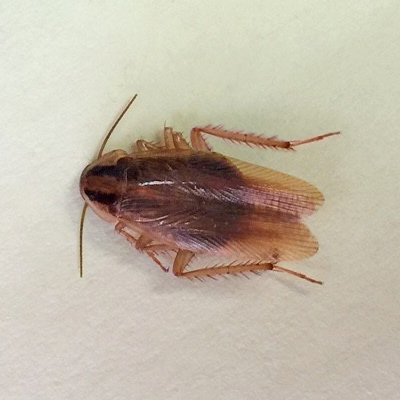
GERMAN COCKROACHES DESCRIPTION
Scientific Name: Blattella germanica Common Name: German Cockroach Color: Varies from light brown to tan Size: 13 to 16 mm long FACT: German cockroaches have wings but do not use them to fly!
Identification
German Cockroaches are 1/2 to 5/8 inches long when mature. They are light brown to tan in colour and have fully developed wings. The pronotum (i.e. shell-like segment behind the head) has two dark parallel bars on it. The adult males are somewhat narrower than the females when viewed from below. The nymphs, 1/8 inches long when they emerge from the egg capsule, are almost uniformly dark except for a light tan area in the back of the second and third segments. As they develop, the light tan area becomes larger until, as mature nymphs, they have two parallel black bars separated by a light tan area. The purse-shaped egg capsule of the German Cockroach is light brown in color, 1/4 to 3/8-inch-long and typically has 15 to 20 eggs per side.
Habits
German Cockroaches are the most common household insect within the United States and Canada. This pest typically infests kitchens and bathrooms but will live anywhere inside heated structures for food, water and harbourage. German Cockroaches gain entry into structures in bags, cardboard boxes, drink cartons, or infested equipment such as used refrigerators, toasters, microwaves etc. These cockroaches feed on all types of human food as well as on pet food, toothpaste, soap, glue, etc.
German Cockroaches are active at night, leaving their harbourage to find food and water. They remain hidden in their dark, secluded harbourage areas (under cupboards, behind cabinets, in wall voids, and around motor housings in appliances) where they spend 75% of their time.
Feeding: German cockroaches are omnivorous scavengers, feeding on all types of human food as well as on pet food, toothpaste, soap, glue, etc.
Hibernation: German cockroaches will live inside of buildings where the temperature is warmer; they will easily live through the entire winter and continue to multiply provided they have water and a food supply.
Nesting: German cockroaches are active at night, leaving their harbourage to find food and water. They remain hidden in their dark, secluded harbourage areas (under cupboards, behind cabinets, in wall voids, and around motor housings in appliances) where they spend 75% of their time.
Reproduction: German cockroaches grow from egg to reproductive adult in about 50 – 60 days. Their entire lifespan is approximately 200 days. Once fertilized, the purse shaped egg capsule of the German cockroach is light brown in color, 6.4 to 9.3 mm long and typically has 15 to 20 eggs per side for approximately 30-40 total young. The young emerge roughly 24 hours after the egg capsule has been released from the female’s body after 30-35 days. About half of all nymphs die before reaching adulthood; the molted skin and dead are eaten by other cockroaches when they emerge if there are not other food sources.
Prevention
A cockroach needs very little to live. A little warmth, a little shelter, and a little moisture, and a small amount of food are all that is required for a cockroach to survive. Roaches prefer environments close to food sources. However, cockroaches can be found in many locations in the home, not just the kitchen.
Because German cockroaches are typically brought into structures, potentially infested products should be closely inspected. Many types of cardboard and plastic traps are available to help pinpoint sources of cockroach infestation and to monitor areas which occupants have complained but infestations cannot be visually detected. Sticky traps are not intended for control but, rather, help identify harbourage areas and to guide and evaluate control efforts as part of the inspection process.
Cockroaches can be found in dirty or unkempt houses so sanitation is key. All food sources available to cockroaches should be eliminated by tidying counter tops, floors and around garbage cans. Also, your appliances should be kept clean. Try not to leave dishes in the sink overnight. Since cockroaches come out at night, they may be drawn to any food left on plates that are sitting in the sink. Any exposed food should be stored in sealed containers.
Control Methods
An effective cockroach management program depends on good sanitation to eliminate food, water and harbourage sites they need for survival. Clean-up to reduce cockroaches in the home and office environment must focus mainly on the food residue in and around coffee machines, microwave ovens, stoves, refrigerators, trash cans, furniture and areas where exposed food is stored. It is critical to reduce clutter, as cockroaches like to hide in stacked boxes and locations near food and water. Vacuum cleaning can be used to physically remove exposed cockroaches. Permanent reduction of cockroach populations can be achieved by caulking to eliminate harbourage areas. The most important piece is to eliminate cracks to reduce hiding sites. These include those in which sinks and fixtures are mounted to the wall and/or floor, around all types of plumbing, baseboard moulding and corner guards where shelves and cabinets meet walls and door frames as well as cracks on or near food preparation surfaces.
Cockroach access routes between apartments and from wall voids and around plumbing and electrical fixtures should be sealed with caulk or grout. Basement floor drains should be protected with screens or basket inserts which should be cleaned regularly.
Residual sprays should be applied to ALL cracks, crevices and around baseboards. Read and follow the label instructions before using ANY product. Even if activity has not been detected within a room, precautions should be taken with a thorough spray treatment of the entire home or business. Also, you should apply insect dust to various cracks and crevices throughout the building. Harbourage areas (under fridge and stove, cracks, crevices, pipe chases, around the toilets and under the kitchen bathroom sinks) should be treated. Once the treatment is done, you must vacate the home for at least 4-6 hours. Infants, seniors, pregnant and people with asthma or health issues should stay away for longer periods of time.
Gel baits may also be used to control cockroaches; however, sanitation plays an important factor to ensure the cockroaches consume the bait and not other food stuffs.
FAQs
Where do cockroaches hide?
When determining where cockroaches may be hiding, search potential pipe chases or sources of water for additional harbourage areas. If a cockroach infestation is present, the aggregation pheromones in their fecal matter cause other cockroaches to harbour in specific areas. These fecal focal points are where these roaches will accumulate and are key in finding and controlling groups of roaches. Roaches follow along edges and other structural lines and can get into almost any small crevasse. Places to begin searching include moldings, counters, shelves, cracks, fume hoods, stoves, dishwashers, water basins, tubs, fridges, columns, cardboard, etc. If they can get into in it, they are likely there.
Are cockroaches afraid of light?
Cockroaches spend approximately 75% of their time in very small and tight cracks and dark crevasses. That’s why if you walk into your kitchen or bathroom and turn on the light, the cockroaches will quickly scatter back into their hiding spots. It’s important to see where they go because you can determine their hiding spots or harbourage areas.
Why won’t a headless cockroach bleed to death?
Well, because of the cockroaches ‘skin’, which is not like our skin, it can close the wound that was created and seal it up, therefore saving any water in its system until it dies of water loss approximately 7 days later.
How long can a cockroach survive without food?
A cockroach can live without food for approximately 30 days, depending on conditions. That means that if it’s getting water at reasonable intervals, and its warm and comfortable, then the cockroach can survive easily until a food source can be found.
Related Videos
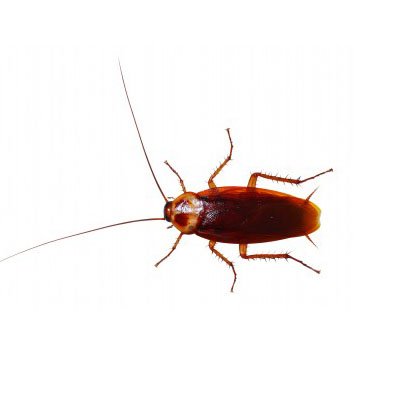
AMERICAN COCKROACH DESCRIPTION
American cockroaches generally live in moist areas but can survive in dry areas if they have access to water. They prefer high temperatures around 29C (84F) and do not tolerate low temperatures. These cockroaches are common in basements, crawl spaces, cracks and crevices of porches, foundations, and walkways adjacent to buildings. In residential areas outside the tropics these cockroaches live in basements and sewers and may move outdoors into yards during warm weather.
Identification
Feeding: American cockroaches will eat a variety of materials such as glue, hair, flakes of dried skin, cheese, pet food, dead animals, tea, leather, food crumbs, and plant materials.
Hibernation: American cockroaches will live inside of buildings where the temperature is warmer; they will easily live through the entire winter and continue to multiply provided they have water and a food supply.
Harbourage Zones: American cockroaches can be found under stoves, fridges, in drains, kitchen cabinets, on the floor, and around appliances.
Reproduction: On average, females produce 9 – 10 oothecae. After about two days, the egg cases are placed on a surface in a safe location. Egg cases are about 0.9 cm (0.35 in) long, brown, and purse-shaped. Immature cockroaches emerge from egg cases in 6 – 8 weeks and require 6 – 12 months to mature. Adult cockroaches can live up to an additional year, during which females produce an average of 150 young.
Prevention
A cockroach needs very little to live. A little warmth, a little shelter, and a little moisture, and a small amount of food are all that is required for a cockroach to survive. Roaches prefer environments close to food sources. However, cockroaches can be found in many locations in the home, not just the kitchen.
Cockroaches can be found in dirty or unkempt houses so sanitation is key. All food sources available to cockroaches should be eliminated by tidying counter tops, floors and around garbage cans. Also, your appliances should be kept clean. Try not to leave dishes in the sink overnight. Since cockroaches come out at night, they may be drawn to any food left on plates that are sitting in the sink. Any exposed food should be stored in sealed containers.
Because cockroaches are typically brought into structures, potentially infested products should be closely inspected. Many types of cardboard and plastic traps are available to help pinpoint sources of cockroach infestation and to monitor areas which occupants have complained but infestations cannot be visually detected. Sticky traps are not intended for control but, rather, help identify harbourage areas and to guide and evaluate control efforts as part of the inspection process.
Control Methods
An effective cockroach management program depends on good sanitation to eliminate food, water and harbourage sites they need for survival. Clean-up to reduce cockroaches in the home and office environment must focus mainly on the food residue in and around coffee machines, microwave ovens, stoves, refrigerators, trash cans, furniture and areas where exposed food is stored. It is critical to reduce clutter, as cockroaches like to hide in stacked boxes and locations near food and water. Vacuum cleaning can be used to physically remove exposed cockroaches. Permanent reduction of cockroach populations can be achieved by caulking to eliminate harbourage areas. The most important piece is to eliminate cracks to reduce hiding sites. These include those in which sinks and fixtures are mounted to the wall and/or floor, around all types of plumbing, baseboard moulding and corner guards where shelves and cabinets meet walls and door frames as well as cracks on or near food preparation surfaces.
Cockroach access routes between apartments and from wall voids and around plumbing and electrical fixtures should be sealed with caulk or grout. Basement floor drains should be protected with screens or basket inserts which should be cleaned regularly.
Residual sprays should be applied to ALL cracks, crevices and around baseboards. Read and follow the label instructions before using ANY product. Even if activity has not been detected within a room, precautions should be taken with a thorough spray treatment of the entire home or business. Also, you should apply insect dust to various cracks and crevices throughout the building. Harbourage areas (under fridge and stove, cracks, crevices, pipe chases, around the toilets and under the kitchen bathroom sinks) should be treated. Once the treatment is done, you must vacate the home for at least 4-6 hours. Infants, seniors, pregnant and people with asthma or health issues should stay away for longer periods of time.
Gel baits may also be used to control cockroaches; however, sanitation plays an important factor to ensure the cockroaches consume the bait and not other food stuffs.
FAQ
Where do cockroaches hide?
When determining where cockroaches may be hiding, search potential pipe chases or sources of water for additional harbourage areas. If a cockroach infestation is present, the aggregation pheromones in their fecal matter cause other cockroaches to harbour in specific areas. These fecal focal points are where these roaches will accumulate and are key in finding and controlling groups of roaches. Roaches follow along edges and other structural lines and can get into almost any small crevasse. Places to begin searching include moldings, counters, shelves, cracks, fume hoods, stoves, dishwashers, water basins, tubs, fridges, columns, cardboard, etc. If they can get into in it, they are likely there.
Are cockroaches afraid of light?
Cockroaches spend approximately 75% of their time in very small and tight cracks and dark crevasses. That’s why if you walk into your kitchen or bathroom and turn on the light, the cockroaches will quickly scatter back into their hiding spots. It’s important to see where they go because you can determine their hiding spots or harbourage areas.
Why won’t a headless cockroach bleed to death?
Well, because of the cockroaches ‘skin’, which is not like our skin, it can close the wound that was created and seal it up, therefore saving any water in its system until it dies of water loss approximately 7 days later.
How long can a cockroach survive without food?
A cockroach can live without food for approximately 30 days, depending on conditions. That means that if it’s getting water at reasonable intervals, and its warm and comfortable, then the cockroach can survive easily until a food source can be found.
Related Videos
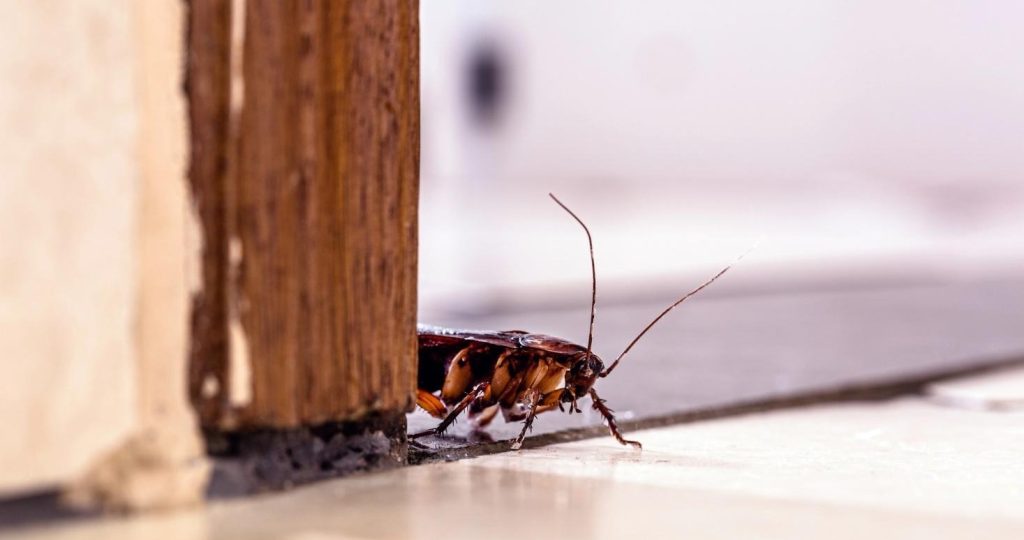
Why Cockroaches Thrive in Alberta’s Homes: Overlooked Structural Issues
When you think of Alberta’s homes, you might picture charming character details. But beneath that charm, there can be hidden structural issues that make these homes a paradise for cockroaches. The problem is that these pests are resilient survivors, and they exploit weaknesses most homeowners don’t even notice. In this blog, we go over common…
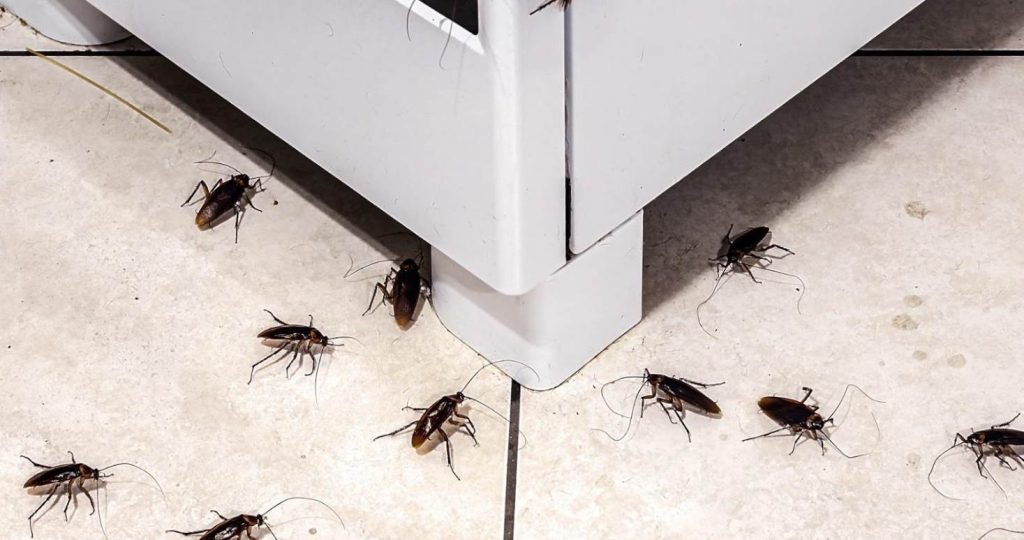
Do-It-Yourself Cockroach Defence: Simple Steps for a Pest-free Home
Cockroaches are more than just an unsettling sight, they’re resilient pests that can pose health risks and quickly multiply if left unchecked. While professional pest control is often the best long-term solution, there are plenty of cockroach prevention tips that Canadian homeowners and renters can follow to keep these unwelcome guests out of their homes. Here…

Think Twice Before You Squash That Roach – Here’s Why
If you’ve ever found a cockroach running across your kitchen floor, your first instinct might be to grab a shoe and squash it. It’s quick, it’s satisfying, and it feels like you’ve taken control. While it might solve the immediate problem, squishing cockroaches isn’t the most effective or hygienic way to deal with them. Here’s…
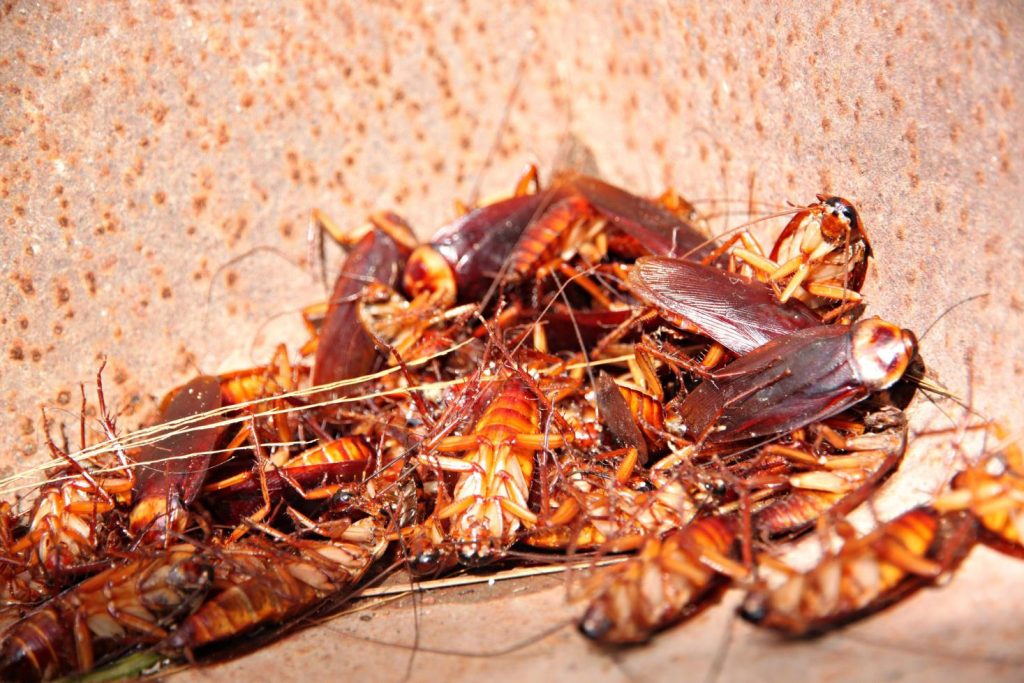
Top Cockroach Hiding Spots in Alberta Homes & How to Prevent Infestations
If you live in Alberta, you might think the cold winters keep your home safe from a cockroach infestation. Unfortunately, this is a myth. Cockroaches are resilient pests that take refuge inside homes and other buildings. Warm, dark, and moist environments are ideal cockroach hiding spots, and knowing this is key to effective cockroach pest…

